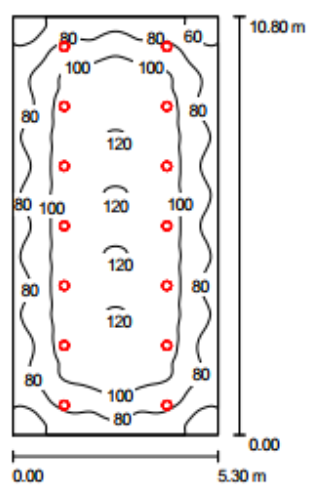Power Consumption Analysis and Evaluation of Energy Saving Potential of Lighting System in DEF Building

Downloads
This study aims to analyze power consumption and evaluate the potential energy savings of the lighting system in the DEF Building, which has various room functions including offices, laboratories, meeting rooms, and libraries. The study was conducted with a descriptive quantitative approach based on field measurement data. Data collection includes measuring lighting intensity (lux), inventory of types and number of lamps, and power consumption (watt). The measurement results were compared with the Indonesian National Standard SNI 6197:2020 to assess the minimum lighting level and maximum power limit. In addition, a simulation of replacing conventional lamps with LED lamps was carried out using Dialux Evo software. The results showed that most rooms had power consumption per square meter that was still efficient (<12 W/m²), but many rooms did not meet the minimum lighting standards. The simulation of replacing lamps with LEDs resulted in significant power savings, with a total reduction in energy consumption of 928.93 kWh per month or equivalent to electricity cost savings of around Rp1,362,997.48. Replacing lamps was also able to improve the quality of lighting in rooms that previously did not meet the standards. This study shows that effective lighting system management through LED lamp retrofitting can be an important strategy in supporting building energy efficiency.
Downloads
[1] K. Naimah et al., “Analysis of Electrical Energy Consumption in Office Buildings of the Institute Technology of Sumatra in Energy Conservation and Efficiency Efforts,” Jurnal Edukasi Elektro, vol. 7, no. 2, pp. 181–194, Nov. 2023, doi: 10.21831/jee.v7i2.65003.
[2] K. Naimah, “Analisa Konsumsi Energi dan Sistem Pencahayaan Gedung C Institut Teknologi Sumatera,” Journal of Energy and Electrical Engineering, vol. 2, no. 2, Apr. 2021, doi: 10.37058/jeee.v2i2.2607.
[3] Vicky Prasetia, Supriyono, and Purwiyanto, “Evaluasi Sistem Pencahayaan Gedung Pendidikan Perkuliahan Sesuai Standar Nasional Indonesia (SNI),” Infotekmesin, vol. 13, no. 2, pp. 308–313, Jul. 2022, doi: 10.35970/infotekmesin.v13i2.1546.
[4] C. Mamahit and P. Pangestu, “Desain dan Analisis Pencahayaan Gedung Bengkel Universitas Negeri Manado,” ELECTRON Jurnal Ilmiah Teknik Elektro, vol. 5, no. 1, pp. 46–52, May 2024, doi: 10.33019/electron.v5i1.72.
[5] M. Krarti, Energy audit of building systems: an engineering approach. CRC press, 2020.
[6] S. Riyadi and J. M. Tambunan, “Analisis Peningkatan Efisiensi Penggunaan Energi Listrik pada Sistem Pencahayaan dan Air Conditioning di Gedung Graha Mustika Ra-tu,” in Prosiding Seminar Nasional Energi & Teknologi (Sinergi), 2018, pp. 107–121.
[7] M. Hemmerling, M. Seegers, and D. Witzel, “Calculation of energy saving potential for lighting with DIALux evo,” Energy Build, vol. 278, p. 112475, Jan. 2023, doi: 10.1016/j.enbuild.2022.112475.
[8] A. M. Al-Ghaili, H. Kasim, N. M. Al-Hada, M. Othman, and M. A. Saleh, “A review: buildings energy savings-lighting systems performance,” IEEE Access, vol. 8, pp. 76108–76119, 2020.
[9] E. Iddio, L. Wang, Y. Thomas, G. McMorrow, and A. Denzer, “Energy efficient opera-tion and modeling for greenhouses: A literature review,” Renewable and Sustainable Energy Reviews, vol. 117, p. 109480, 2020.
[10] Badan Standar Nasional, Konservasi energi pada sistem pencahayaan. 2020.
[11] N. Pratiwi and A. G. Djafar, “Analysis of Lighting Performance in the Hall of the Fac-ulty of Engineering, State University of Gorontalo by using the DIALux Evo 9.0 Simu-lation,” IOP Conf Ser Earth Environ Sci, vol. 738, no. 1, p. 012032, Apr. 2021, doi: 10.1088/1755-1315/738/1/012032.
[12] I. Fryc, M. Listowski, R. Supronowicz, and C. Martinsons, “Selecting Energy-Efficient LED Retrofits with Optimal Color Qualities for New and Refurbished Buildings,” En-ergies (Basel), vol. 18, no. 1, p. 112, Dec. 2024, doi: 10.3390/en18010112.
[13] S. Gorgulu and S. Kocabey, “An energy saving potential analysis of lighting retrofit scenarios in outdoor lighting systems: A case study for a university campus,” J Clean Prod, vol. 260, p. 121060, 2020.
[14] O. Sadeghian et al., “A comprehensive review on energy saving options and saving potential in low voltage electricity distribution networks: Building and public light-ing,” Sustain Cities Soc, vol. 72, p. 103064, Sep. 2021, doi: 10.1016/j.scs.2021.103064.
[15] Z. He, T. Hong, and S. K. Chou, “A framework for estimating the energy-saving poten-tial of occupant behaviour improvement,” Appl Energy, vol. 287, p. 116591, Apr. 2021, doi: 10.1016/j.apenergy.2021.116591.
[16] N. Kunwar, K. S. Cetin, U. Passe, X. Zhou, and Y. Li, “Energy savings and daylighting evaluation of dynamic venetian blinds and lighting through full-scale experimental testing,” Energy, vol. 197, p. 117190, Apr. 2020, doi: 10.1016/j.energy.2020.117190.
[17] A. Kerem, “Assessing the electricity energy efficiency of university campus exterior lighting system and proposing energy-saving strategies for carbon emission reduc-tion,” Microsystem Technologies, vol. 28, no. 12, pp. 2623–2640, 2022.
[18] M. Awang et al., “Assessment of energy saving potential and lighting system in teach-ing building,” Journal of Advanced Research in Fluid Mechanics and Thermal Sci-ences, vol. 65, no. 1, pp. 159–169, 2020.
[19] P. Belany, P. Hrabovsky, and Z. Kolkova, “Combination of lighting retrofit and life cycle cost analysis for energy efficiency improvement in buildings,” Energy Reports, vol. 7, pp. 2470–2483, Nov. 2021, doi: 10.1016/j.egyr.2021.04.044.
[20] D. Zheng, L. Yu, and L. Wang, “Research on Large-Scale Building Energy Efficiency Retrofit Based on Energy Consumption Investigation and Energy-Saving Potential Analysis,” Journal of Energy Engineering, vol. 145, no. 6, Dec. 2019, doi: 10.1061/(ASCE)EY.1943-7897.0000618.
[21] A. Powers and M. Saad, “Building Energy Use: Modeling and Analysis of Lighting Systems—A Case Study,” Sustainability, vol. 14, no. 20, p. 13181, Oct. 2022, doi: 10.3390/su142013181.
[22] P. Mandal, D. Dey, and B. Roy, “Optimization of luminaire layout to achieve a visual-ly comfortable and energy efficient indoor general lighting scheme by Particle Swarm Optimization,” LEUKOS, vol. 17, no. 1, pp. 91–106, Jan. 2021, doi: 10.1080/15502724.2018.1533853.
[23] O. Sadeghian et al., “A comprehensive review on energy saving options and saving potential in low voltage electricity distribution networks: Building and public light-ing,” Sustain Cities Soc, vol. 72, p. 103064, 2021.
[24] S. Bunjongjit and A. Ngaopitakkul, “Feasibility study and impact of daylight on illu-mination control for Energy-saving lighting systems,” Sustainability, vol. 10, no. 11, p. 4075, 2018.
Copyright (c) 2025 Jurnal Edukasi Elektro

This work is licensed under a Creative Commons Attribution-ShareAlike 4.0 International License.
The Authors submitting a manuscript do so on the understanding that if accepted for publication, copyright publishing of the article shall be assigned to Journal.



















